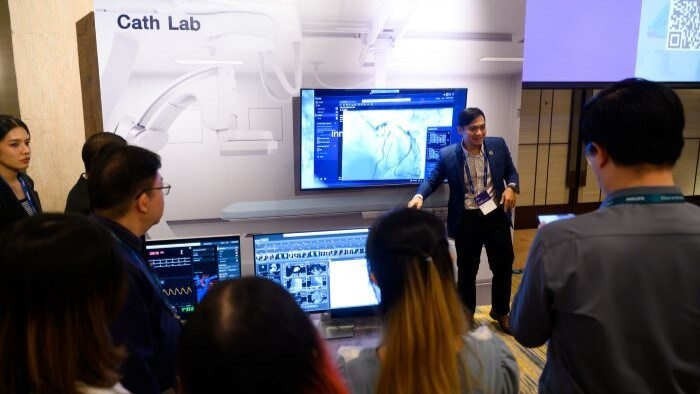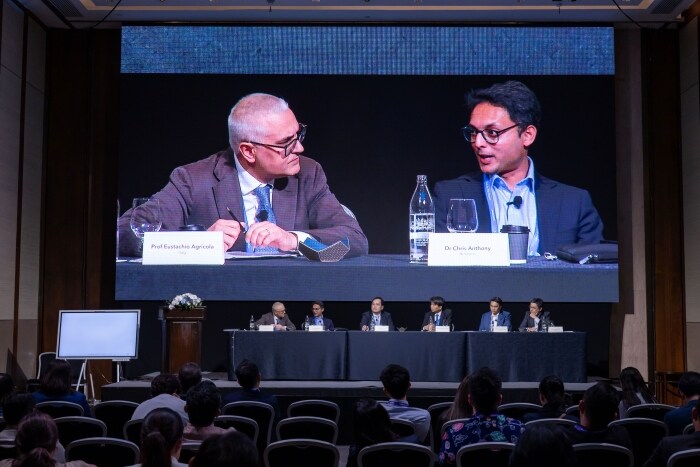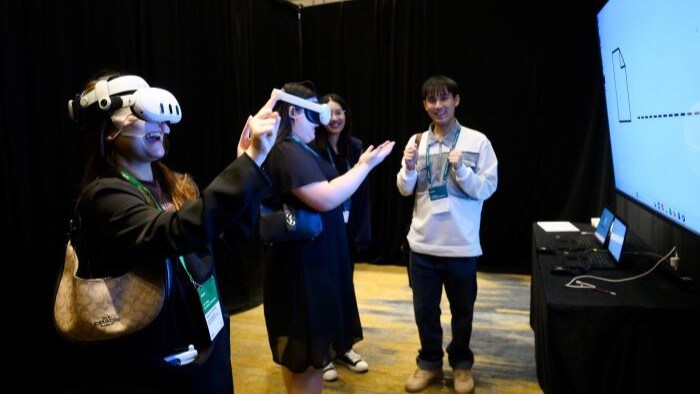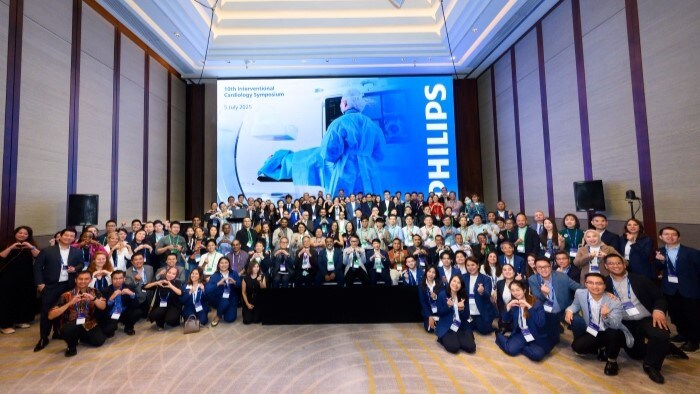On July 5, Bangkok once again became a regional hub for interventional cardiology innovation as Philips hosted the 10th annual APAC Cardiology Symposium—an immersive platform designed to elevate the practice of cardiovascular care through hands-on learning, clinical collaboration, and thought leadership.

Rooted in a deep understanding of the challenges interventional cardiology teams face—and a shared passion for delivering better heart care—the symposium brought together over 100 clinicians and nurses from eight countries—including Thailand, Indonesia, Singapore, Vietnam, Malaysia, the Philippines, India, and the UAE—for a full day of interactive learning focused on the most pressing challenges in coronary disease, structural heart disease, and cath lab efficiency.
Celebrating its 10th year, the symposium continued to serve as a trusted platform for cardiovascular teams across APAC to exchange ideas, explore emerging innovations, and co-create solutions that are truly patient-focused.
Our goal is not just to showcase technology, but to bring together the brightest minds in cardiology to inspire collaboration, raise standards of care, and support better outcomes for more patients across the region.”
Concon Molina, MD
Head of Image Guided Therapy Systems, APAC and Marketing Leader, Growth Region, Philips
Coronary disease track: Real-world complex PCI techniques

Coronary artery disease (CAD) remains the most common form of heart disease worldwide. Minimally invasive techniques like percutaneous coronary intervention (PCI) are critical in restoring blood flow to blocked arteries—yet these procedures are becoming more complex and demanding.
The Coronary Disease track tackled how imaging innovations can support clinicians in treating high-risk patients safely and effectively through hands-on sessions, complex case discussions, and live-recorded walk-throughs. Participants explored advanced imaging techniques and real-world strategies for navigating calcified vessels and managing high-risk, repeat-intervention patients. A highlight of the track was the “PCI Case in Point” segment, where leading clinicians—including Thailand’s Dr. Nattawut Wongpraparut—demonstrated techniques in high-stakes PCI scenarios.
I think Fiber Optic Real Shape (FORS) technology, which allows us to navigate without Fluoroscopy, has great potential to improve clinical practice in the future.”
Dr. Nattawut Wongpraparut
Interventional Cardiologist, Siriraj Hospital
A major area of focus was reducing radiation exposure during PCI—an ongoing concern for both patients and cath lab teams. Attendees heard updates from the global RADIQAL clinical trial, which is investigating whether new ultra-low dose imaging can maintain procedural quality while significantly lowering radiation levels. The ability to reduce radiation exposure without compromising procedural performance is a key priority in interventional cardiology, as interventional cardiologists rely on low-dose, high-quality imaging for confident decision-making throughout multiple procedures each day. For patients with high BMI or complex conditions requiring repeat interventions, minimizing radiation exposure is increasingly critical.
Looking ahead, leading clinicians also expressed interest in emerging 3D navigation tools that could reduce reliance on fluoroscopy and enhance visual guidance in complex vascular interventions.
“I think Fiber Optic Real Shape (FORS) technology, which allows us to navigate without Fluoroscopy, has great potential to improve clinical practice in the future,” said Dr. Nattawut Wongpraparut, Interventional Cardiologist, Siriraj Hospital.
Philips’ approach reflects a deep commitment to empowering cath lab teams with smarter tools—bringing clinical confidence at each step of the patient journey.
Structural heart disease (SHD) track: Multimodality meets teamwork

The SHD track emphasized the power of multimodality imaging and team-based planning to manage increasingly complex structural heart conditions. Through recorded case reviews, panel discussions, and expert lectures, participants explored how imaging advances—from echocardiography to CT—are improving precision in diagnosing and treating conditions like valve disease and heart failure.
A key takeaway was how imaging improvements are helping expand treatment options for patients previously considered difficult to assess.
Advances in 3D imaging are really transforming how we assess and treat structural heart patients—especially those with challenging anatomy or limited imaging windows.”
Dr. Chris Anthony
Advanced Multi-Modality Cardiac Imaging Cardiologist, Alfred Hospital and Epworth Hospital Richmond, Australia
“Advances in 3D imaging are really transforming how we assess and treat structural heart patients—especially those with challenging anatomy or limited imaging windows,” said Dr. Chris Anthony, Advanced Multi-Modality Cardiac Imaging Cardiologist at Alfred Hospital and Epworth Hospital Richmond, Australia. “What excites me most is the ability to perform high-quality assessments in the clinic—non-invasively and without the need for contrast or radiation. That kind of insight early in the patient journey allows me to plan procedures more effectively and open up options that may not have been possible before.”
The track also highlighted how collaborative dialogue across specialties is essential in structural heart care—linking diagnostics, intervention, and patient management in a continuous, connected workflow. Philips supports this multidisciplinary approach through innovations that connect teams and data across the care pathway—helping care providers deliver what matters most: meaningful patient outcomes.
Cardiac workflow track: Streamlining decisions under pressure

As demand for interventional procedures continues to grow, cath lab teams face increasing pressure to work faster and smarter—without compromising care.
The Cardiac Workflow track focused on how workflow innovation and real-time decision support tools are enabling this shift. A crowd favourite was the “Escape Room” challenge, a gamified exercise where participants solved clinical scenarios using vital signs and collaborative problem-solving.
Complementing the activity were sessions on continuous patient monitoring, intuitive interface design, and data visualization—all designed to reduce cognitive load, ease training, and support efficient team deployment.
Innovations that simplify workflows and support situational awareness—especially those that reduce cognitive overload—play a critical role in ensuring clinical teams can operate effectively and deliver precise, personalized care.”
Colin Toscano
Senior Product Manager, Philips Hospital Patient Monitoring
“With aging populations and rising multimorbidity, clinicians in interventional cardiology are managing an unprecedented volume of information in real time,” said Colin Toscano, Senior Product Manager, Philips Hospital Patient Monitoring. “Innovations that simplify workflows and support situational awareness—especially those that reduce cognitive overload—play a critical role in ensuring clinical teams can operate effectively and deliver precise, personalized care.”
The Cardiology Patient Story Carousel added a human dimension, allowing attendees to walk through real patient journeys and reconnect with the personal impact behind the clinical data.
A platform for long-term partnerships

Throughout the day, Philips reaffirmed its role not only as a technology innovator, but as a partner in healthcare transformation. By investing in clinical collaboration, education, and customer co-creation, the symposium underscored how industry and healthcare systems can work together to raise the standard of cardiovascular care.
Whether by supporting national health strategies, building clinical capacity, or co-developing future models of care, Philips remains focused on one goal: Better care for more people.
Share on social media
Topics
Contact

Tan Yi Xian Communications and Brand Manager, ASEAN
You are about to visit a Philips global content page
Continue











